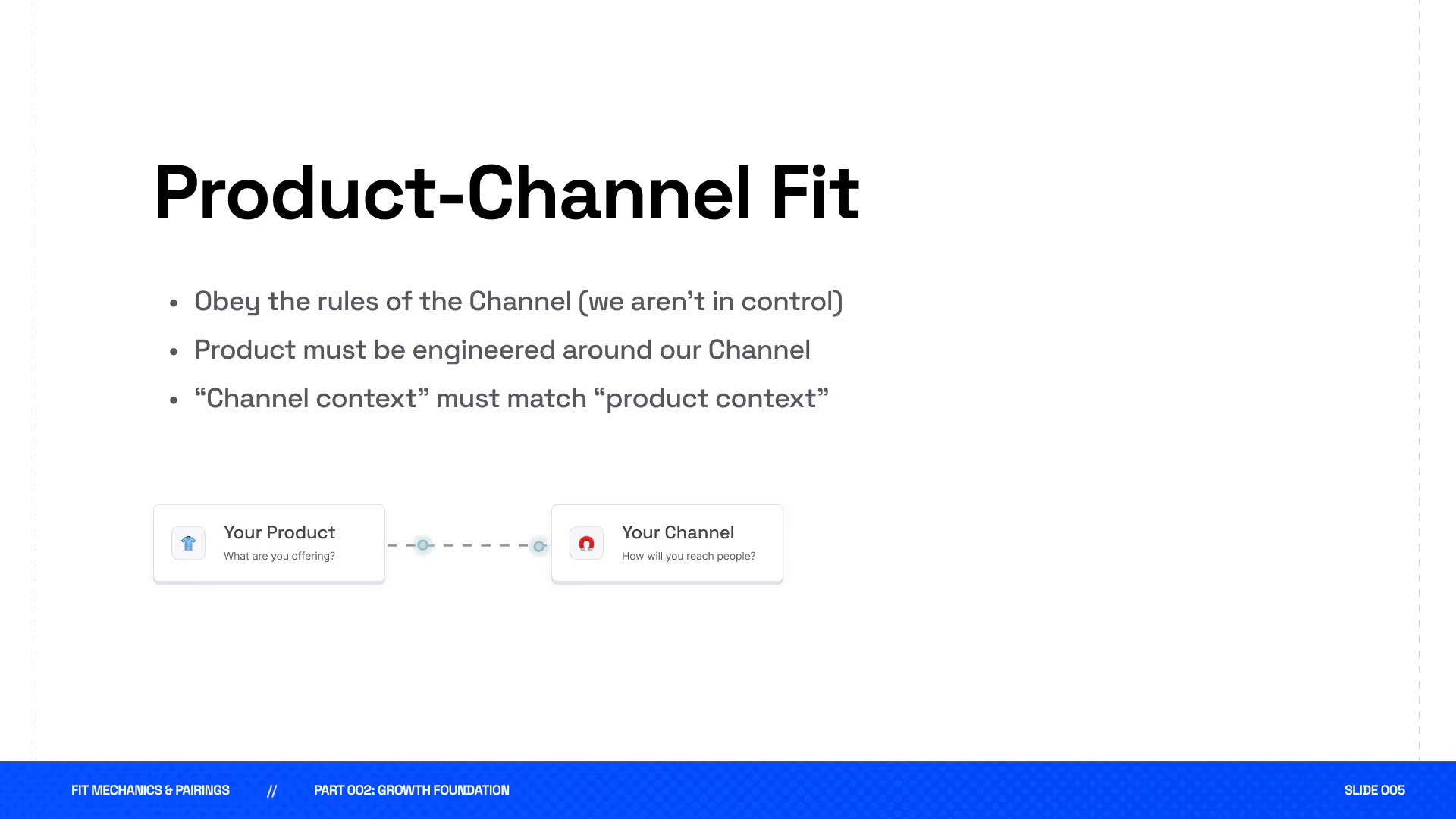
Conversation

🥳 Feedback Received!
Thanks for taking a moment to share your thoughts — it genuinely helps us make each chapter sharper.
What happens next:
- Your feedback goes straight to our product team.
- We’ll use it to refine lessons, clarify examples, and make the program even more useful.
Appreciate you helping make this program better for everyone.
Ready for your next challenge? 👇
Product-channel fit
Product-Channel Fit is one of the most overlooked but highest-leverage pairings.
The core idea is that channels have fixed "rules of the road," and you must engineer your product to fit those rules, not the other way around.

1. Obey the Rules of the Road
Every channel has its own physics: the format of its content, the context in which users engage, the pace at which information is consumed, unique APIs and algorithms under the hood—just to name a few.
Here's a very broad view of what the major channel categories require from our product:
- Virality requires a simple value proposition, a product that is easy to use and provides a very fast time to value. It benefits from a large market and therefore a broad value proposition that appeals to a wide percentage of users' networks. Ideally, the product has network effects that make it better as more users join.
- Paid Marketing is similar in requiring a quick time to value and a broadly appealing, simple value proposition. Users generally have less context and buying intent (and patience for that matter) when they come from ads, so immediate value delivery is critical. As is being in a known product category. Ideal products are aesthetically pleasing and visual in nature in order to break through the noise on crowded ad platforms.
- Content Marketing once again, content has a wider range than other channels. Content, when paired with sales, can support complicated, abstract products that aren’t aligned with virality or paid. But given the multitude of channels and array of media formats, it’s also a great fit for beautiful products regardless of complexity. Content as a category is particularly impactful for products that have an educational component associated with them. Be it that the product itself is content, education, etc. or that users are seeking education in the general product category.
- Sales handles the most complex products that require education, demonstration, and high degrees of proof. These products often have longer implementation cycles and higher price points that justify the human touch required in sales processes.
This brings us to a critical point that we emphasize throughout the Growth Program: growth cannot be slapped on top of your product.
We constantly hear founders say,
"Right now we're just heads down focusing on Product-Market Fit, but once we get it, then we'll start testing a bunch of channels and see what sticks."
This is a really common approach with early-stage startups who think that Product-Market Fit is all it takes, and then they can just add some channels and ride off into the sunset.
What we're showing here is that's just not how it works. Just like we have to build our product for our market and not the other way around, we have to build our product for our channel as well.
2. Engineering the Fit: Creating Through-Lines
To engineer this fit, you map your product's attributes to the inherent rules of your target channels.
Let's see how Mindful could evaluate fit with the “Paid” channel category.
For this example, we’ll choose a specific paid channel: Meta Ads.
Because Mindful's product is mobile-native, delivers value quickly, and has visual appeal, it’s well-aligned to a paid social channel like Meta.
Mindful aligns with the “Context” and “Intent” of the channel. And the Product dynamics match that of Meta (high-scale and fast time-to-results channels require simple, frictionless products).
3. Assessing the Fit: How to Know You Have It
Assessing Product-Channel fit involves looking at the efficiency of your funnel and the quality of users you acquire from each channel.
Funnel Conversion Rates: Are users who come from a specific channel moving smoothly through your funnel? High drop-off rates between channel engagement and product activation can signal a mismatch between the channel's context and your product's experience.
Channel-Level Cohort Retention: Are users acquired from particular channels retaining at similar rates? If users from one channel churn much faster than others, it may indicate that the channel is attracting the wrong type of user. Or maybe even the right kind of user, but in the wrong context.
Engagement Quality: Beyond just conversion and retention, are users from different channels engaging with your product in the intended way? Some channels might drive users who convert but never fully adopt your product's core value proposition.
4. Important Considerations
Channel Evolution: Channels themselves evolve over time, changing their algorithms, formats, and user behaviors. What works for Product-Channel Fit today may not work tomorrow. Successful companies continuously monitor how channel changes affect their product's performance and adapt accordingly.
Multi-Channel Strategy: Most successful companies don't rely on a single channel. Product-Channel Fit helps you understand which combinations of channels can work together effectively, and which might create conflicting user expectations or experiences.
Product Evolution for Channels: Sometimes the most strategic move is to evolve your product to better fit high-potential channels, rather than trying to force your current product into misaligned channels. This is particularly relevant for early-stage companies that still have flexibility in their product development.


